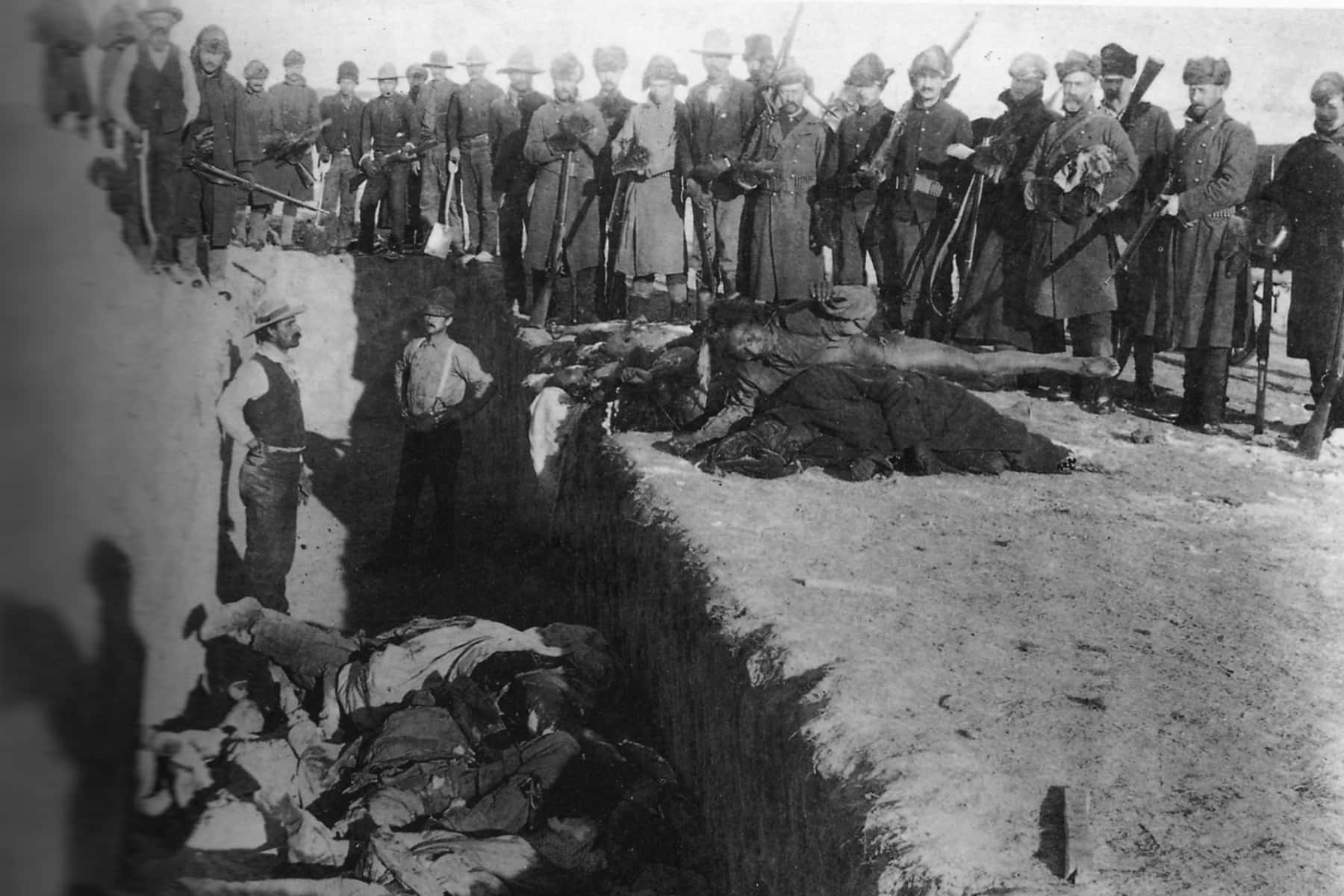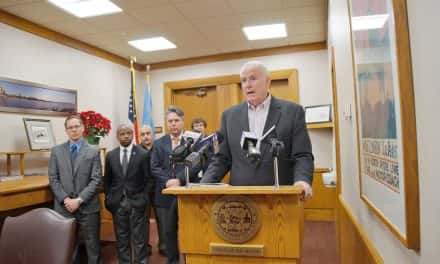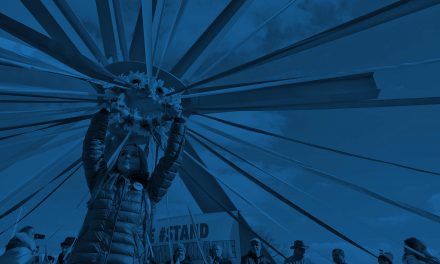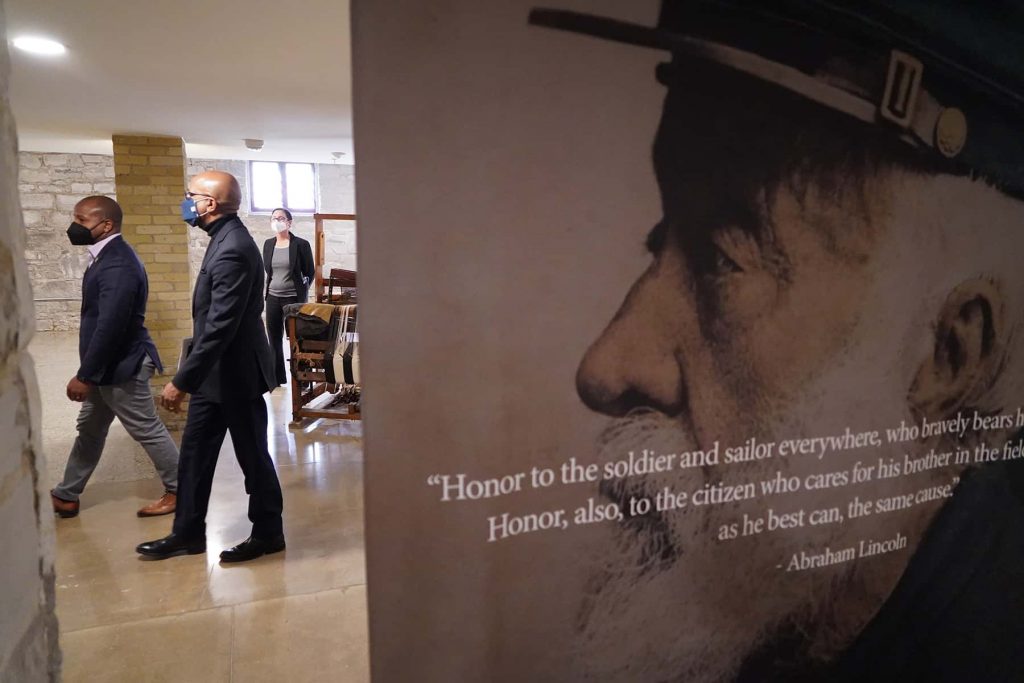
“This land is your land and this land is my land
From California to the New York island
From the redwood forest to the Gulf Stream waters
This land was made for you and me”
Woody Guthrie’s 1944 folk song
In light of the twentieth anniversary of the September 11 terrorists attacks, most Americans memories of terrorism are related to that horrific day. I clearly remember that day as if it just happened. There are images and sounds from that day that will never leave my consciousness.
However, we as Americans need to be clearly aware of two things. First, terrorism has been a part of the American experience for the entire length of the history of the nation. And secondly, most acts of terrorism in this country since that horrible day have been acts of domestic terrorism.
We should begin by exploring this account from the book, Bury My Heart at Wounded Knee: An Indian History of the American West by Dee Brown discussing what happened to the natives who discovered to their dismay, that the English and Dutch in their midst were not their friends as the Thanksgiving myth tells us.
“The Powhatans rose in revenge to drive the Englishmen back into the sea from which they had come, but the Indians underestimated the power of English weapons. In a short time the eight thousand Powhatans were reduced to less than a thousand … By the time Massasoit, great chief of the Wampanoags, died in 1662 his people were being pushed back in to the wilderness … In 1641, William Kieft levied tribute upon the Mahicans and sent soldiers to Staten Island to punish the Raritans for offenses which had been committed not by them but by white settlers. The Raritans resisted arrest, and the soldiers killed four of them. When the Indians retaliated by killing four Dutchmen, Kieft ordered the massacre of two entire villages while the inhabitants slept. The Dutch soldiers ran their bayonets through men, women, and children, hacked their bodies to pieces, and then leveled the villages with fire. For two more centuries these events were repeated again and again as the European colonists moved inland through the passes of the Alleghenies and down the westward-flowing rivers to the Great Waters (the Mississippi) and then up the Great Muddy (the Missouri).”
This short accounting of early terrorism inflicted on the natives was just the tip of the iceberg. We don’t teach this part of American history in school. The massacres inflicted on Native Americans from “sea to shining sea” are not a part of the American myth of brave settlers, fur traders, mountain men, cowboys, missionaries, and homesteaders. This was the original sin of America. The taking of this land we all call the United States of America, is a story of terrorism. There is no honest way to talk about American history without retelling these stories of atrocities.
Unfortunately, historians have done us all a disservice by leaving these well documented atrocities out of the story of America we all learn. It is shameful and harmful to leave this part out of the history classes that millions of us have sat through.
What we learn about the so-called “Great Indian Wars,” is that the Indians precipitated the violence because the were supposedly “savages.”
Roxanne Dunbar-Ortiz wrote in her 2015 American Book Award winner, An Indigenous Peoples’ History of the United States:
“Under the crust of that portion of Earth called the United States of America — “from California … to the Gulf Stream waters.” Are interred the bones, villages, fields, and sacred objects of American Indians. They cry out for their stories to be heard through their descendants who carry the memories of how the country was founded and how it came to be as it is today.”
We as a nation don’t celebrate the resistance to this land theft and massive doses of violence by calling the Native Americans heroes. America refuses to acknowledge the truth of the brutal force used over generations to acquire this land we call home. The terrorism used to take it is instead recorded in our history books as the acts of brave settlers, intent on protecting the lands they felt God gave them the right to take and do with as they pleased.
The father of the nation, George Washington, is remember differently by the Native Americans of his time. They called him the “town destroyer” for ordering their communities to be leveled by any means necessary. Their was no empathy or compassion in his heart for these people.
President Andrew Jackson, is most famous for pushing through Congress, the Indian Removal Act in 1830. The removal of these Native communities in his mind was not possible without using extreme violence, terrorizing those who refused to comply.
“It gives me pleasure to announce to Congress that the benevolent policy of the Government, steadily pursued for nearly thirty years, in relation to the removal of the Indians beyond the white settlements is approaching to a happy consummation … The consequences of a speedy removal will be important to the United States, to individual States, and to the Indians themselves … It puts an end to all possible danger of collision between the authorities of the General and State Governments on account of the Indians. It will place a dense and civilized population in large tracts of country now occupied by a few savage hunters … it will incalculably strengthen the southwestern frontier and render the adjacent States strong enough to repel future invasions without remote aid. It will relieve the whole State of Mississippi and the western part of Alabama of Indian occupancy, and enable those States to advance rapidly in population, wealth, and power. It will separate the Indians from immediate contact with settlements of whites; free them from the power of the States; enable them to pursue happiness in their own way and under their own rude institutions; will retard the progress of decay, which is lessening their numbers, and perhaps cause them gradually, under the protection of the Government and through the influence of good counsels, to cast off their savage habits and become an interesting, civilized, and Christian community.”
Many attempts to have peaceful relations with Whites were clearly articulated by the leaders of Native American groups over generations. They did not want war. They wanted peace and a continuation of their way of life.
“We never did the white man any harm; we don’t intend to … We are willing to be friends with the white man.”
– Tonkahaska (Tall Bull) to General Winfield Scott Hancock
Hancock later responded to a group of Cheyenne chiefs with these words:
“I have heard great many Indians want to fight. Very well, we are here, and come prepared for war. If you are for peace, you know the conditions. If you are here for war, look out for the consequences.”
These men knew all too well the consequences. On the 29th of November 1864, a group of 675 men in the Third Colorado Cavalry had committed what’s know as the Sand Creek Massacre in eastern Colorado. Their leader, Colonel John Chivington, a Methodist pastor, had uttered these words prior to the massacre.
“Damn any man who sympathizes with Indians! I have come to kill Indians, and believe it is right and honorable to use any means under God’s heaven to kill Indians.”
Chivington had made a public speech in Denver not long before the massacre that he would be happy to kill, and scalp all Indians including infants. About 600 Cheyenne and Arapaho were camped out in the horseshoe bend of the Sand Creek. Most of their warriors were several miles away hunting buffalo to feed their families. They had been ordered to leave and go on this trip by Major Scott Anthony. Around sunrise, the soldiers attacked without warning. The troops surrounded the encampment and fired from both sides. Ironically, the Native Americans were flying the American flag over their camp when the gunfire began.
Those who encountered the troops yelled for them to stop and proclaimed loudly that they had no intention of fighting their “friends” the White men. For this kind gesture, they were murdered in cold blood. The soldiers killed children, women, and elders of the community. No one was off limits. A majority of the adult men were out hunting buffalo and could not protect their families.
As they waved white flags of surrender, they were butchered by the cannons and rifles of the U.S. troops. The troops brutally killed and scalped the Indians, taking body parts as souvenirs, a forecast of future actions seen during spectacle lynchings of Blacks. They cut pregnant women open and pulled out their unborn children, smashing their heads with the butt of their rifles. A witness to the terroristic massacre, Robert Bunt, described the atrocities.
“In going over the battleground the next day I did not see body of man, woman, or child but was scalped, and in many instances their bodies were mutilated in the most horrible manner — men, women, and children’s privates were cut out … I heard one man say that he had cut out a woman’s private parts and had them for exhibition on a stick; I heard another man say he had cut the fingers off an Indian to get the rings on the hand … I also heard of numerous instances in which men had cut out the private parts of females and stretched them over the saddle-bows and wore them over their hats while riding in the ranks.”
I remember as a child watching the cowboys and Indians movies and shows on television. All of them portrayed the Indians as “savages” and talked about them scalping White settlers. I never heard of the murder of 150 total at Sand Creek, most of them women and children in school or in the movies. Colonel Chivington bragged that his troops had killed five hundred. They burned the village to the ground on their way out. Several chiefs including White Antelope, One-Eye and War Bonnet were killed.
One of the last remaining leaders, Chief Leg-in-the-Water, remarked later that he would not seek peace with Whites.
“But what do we want to live for? The white man has taken our country, killed all of our game; was not satisfied with that, but killed our wives and children … We loved the whites until we found out they lied to us, and robbed us of what we had.”
Later the Cheyenne, Arapaho, and Sioux retaliated by attacking wagon trains, stage coaches, and small military outposts as well as burning the town of Julesburg, scalping Whites in response to those from their tribes who had been scalped. This retaliation is what is portrayed, with no context, in so many movies and books about so-called Indian Wars. The events which precipitate the retaliation are never covered.
The Sand Creek Massacre, is one of many such acts of terrorism perpetrated by the U.S. government troops for generations. In 1890, the Massacre at Wounded Knee on the Pine Ridge reservation in South Dakota, played out in similar fashion, this time with over 300 Indians murdered. Historian John Grenier wrote about this use of the military in these attacks in his book, The First Way of War.
“For the first 200 years of our military heritage, then, Americans, depended on arts of war that contemporary professional soldiers supposedly abhorred: razing and destroying enemy village and fields; killing enemy women and children; raiding settlements for captives; intimidating and brutalizing enemy combatants; and assassinating enemy leaders … In the frontier wars between 1607 and 1814, Americans forged two elements — unlimited war and irregular war — into their first way of war.”
General Philip Sheridan in 1869 infamously told Comanche chief Toch-a-way, “the only good Indian I ever saw was dead.” This story was later retold as him saying, “the only good Indian is a dead Indian.”
The bloody lust for land and power manifested into acts of terrorism that we as a nation refuse to call terrorism. To call it that would muddy the stories of the frontier, brave settlers and soldiers and the justification for manifest destiny.
Watching those heroic interpretations of cowboys and settlers by Hollywood made me, like many children I am sure, always want to be the cowboy and never the Indian.
“It comes as a great shock … to discover that the flag to which you have pledged allegiance … has not pledged allegiance to you. It comes as a great shock to see Gary Cooper killing off the Indians, and although you are rooting for Gary Cooper, that the Indians are you.” – James Baldwin
This history is the genesis of terrorism in America. It would eventually spread to other communities, particularly in those of people of African descent. We have seen in recent years, Hollywood is finally giving Black producers and directors the ability to portray the ugly violence of slavery in movies like 12 Years a Slave. The years following the Civil War from 1865 to 1877, is known as Reconstruction by historians.
What is generally not well known about that time, is the massive acts of terroristic violence that was suffered by the newly freed African Americans. The 13th, 14th and 15th Amendments are celebrated as bringing Blacks freedom, citizenship, and voting rights to Black men. What we rarely hear is that having access to these these new rights did not come easily. There was a period of massive anti-black violence that is hidden from most of us during Reconstruction when the Union troops were supposedly protecting Black people. Murders of Blacks were more common then than at any other point in American history, because of the bloodlust of the Southerners who’s lost the war and needed to take it out on someone.
Most people have heard about the founding of America’s first organized, citizen led terrorist organization, the Ku Klux Klan in Pulaski Tennessee just after the war ended. They were far from the only group that terrorized Black people.
The Freedmen’s Bureau, created to ease Blacks as they transitioned into freedom, has a tremendous amount of reports of violence against these “freedmen.” These are a few documented cases of murders and other atrocities form their records.
Alabama in 1866: Freedman killed with an axe in Butler County. Three freedmen killed by two brothers in Shelby County, April; Freedman & freedwoman killed, thrown into a well in Jefferson Co., April; Freedman killed for refusing to sign a contract, Sumter Co., May; Freedman found hung by a grapevine in woods near Tuscaloosa, May; Freed girl beaten to death by two white men near Tuscaloosa, July; Freedman shot dead while at his usual work, near Tuscaloosa, September; March – Bradley killed freedwoman with an axe Montgomery; April 3 – Woman taken by three men out of her house in middle of night to swamp & badly whipped – beaten on head with pistol; May 7 – Moore taken to woods & hung till nearly dead to make him tell who robbed a store, at Tuscaloosa; May 29 – Colored man killed by Lucian Jones for refusing to sign contract, in upper part of Sumter Co.; May 29 – Richard Dick’s wife beaten with club by her employer. Richard remonstrated – in the night was taken from his house and whipped nearly to death with a buggy trace by son of the employer & two others; June 16 – Mr. Alexander, colored preacher, brutally beaten & forced to leave his house at Auburn, Ala.; July 16 – Black girl beaten to death by Washington and Greene McKinney, 18 miles west of Tuscaloosa; September 14 – Black man picking fodder in a field shot dead — & another who had difficulty with a white man abducted & supposed to have been murdered near Tuscaloosa; September 3 – Murderous assault upon returned black Union soldier in Blount Co.; July 26 – Jno. Dunn beat freedwoman severely – trial a farce. Jas. Pryor, 8 miles from Greenville, assaulted freedman & committed outrage on a freedwoman; August – Gang of ruffians in Clarke Co. set fire to house & fired on family as they ran from it – one killed, two wounded; February 1866 – Freedwoman beaten with club by her employer near Selma, head cut in most shocking manner; June 1866 – Freedman shot while at his usual work by his employer for threatening to report his abusive conduct to the authorities of the Bureau – Mobile; June 1866 – Freedwoman severely burned by a Policeman while in the guard house – Montgomery; December 1866 – Freedman killed by parties unknown, brought to hospital in dying condition, shot through brain.
This is a very short list of some of the atrocities in Alabama in the year after the 13th Amendment ended state sponsored enslavement. There are reports in other states entitled: Report of assaults with intent to murder, committed upon freed people in the division of Albany from January 1st to October 31st 1868; 1865-66 Report of persons murdered in the district of Atlanta, Georgia; Supplemental List of Murders and Outrages committed in the State of Louisiana During the Month of November 1868; Freedmens Bureau Reports of murders and outrages, October 1865-November 1868 in South Carolina; Report of Outrages Committed by Whites on Freedmen in the Memphis Sub District, Bureau R. F. A. L. For the month of May 1867; Reports of murders, outrages &c., committed on white men and freedmen in Washington County, Texas; Freedmens Bureau Report of Abuses of Freedmen in Richmond, Virginia.
The list goes on and on. This was all a precursor to decades public lynchings of Blacks. In 2010 an incredible book was published called, Without Sanctuary: Lynching Photography in America. The book documented dozens of lynching photos and particularly, lynching postcards discovered by James Allen who describes himself in the book as “a picker. It is my living and my avocation. I search out items that some people don’t want or need and then sell them to others.”
He talked about how he felt after studying these lynching photographs by saying:
“Studying these photographs has engendered in me a caution of white s. Of the majority, of the young, of religion, of the accepted … a trader pulled me aside and in conspiratorial tones offered to sell me a real postcard. It was Laura Nelson hanging form a bridge, caught so pitiful and tattered and beyond retrieving — like a paper kite snagged on a utility wire. That image of Laura layered a pall of grief over all my fears … the photographic art played as significant a role in the ritual as torture or souvenir grabbing … Lust propelled the commercial reproduction and distribution of the images, facilitating the endless replay of anguish. Even dead, the victims were without sanctuary.”
Back in 1962, Ralph Ginzburg catalogued lynchings in America in his book, 100 Years of Lynchings. His methodology was simple. He looked for newspaper and magazine articles that documented lynchings and put them together as an example of how common lynchings were but also to show how there was rarely in the White press and abhorrence or criticism of theses lynchings. He mentions in the foreword to the book an article showing how lynchings were in many cases the guilt of Whites that was often shifted unto Blacks. One such story form the New York Herald Tribune on February 9, 1936 told the story of a mob that hang a Black man accusing him of rape of a White woman. Later the leader of the mob, a White man, was convicted of the rape.
“I shall not discourse upon the horror of the white man’s treatment of the black man in American history. The facts in this book speak too eloquently for themselves.”
This is a short list of headlines from the book: Chicago Tribune November 22, 1895, Texans Lynch Wrong Negro; Springfield (Massachusetts) Weekly Republican April 28, 1899, Negro Burned Alive in Florida; Second Negro Then Hanged; Chicago Record Herald May 23, 1902, Negro Tortured to Death By Mob of 4,000; New York Press February 8, 1904, Negro and Wife Burned; Vicksburg (Mississippi) Evening Post February 8, 1904, Lynched Negro and Wife Were First Mutilated; Chattanooga Times, February 13, 1898, Blood-Curdling Lynching Witnessed by 2,000 Persons.
I could go on, but I think you get the point. The Equal Justice Initiative in Montgomery, Alabama tells us that, “The lynching of African Americans was terrorism, a widely supported campaign to enforce racial subordination and segregation. Lynching in America documents more than 4400 racial terror lynchings in the United States during the period between Reconstruction and World War II.”
In 1892, abolitionist Frederick Douglas penned an article he called, Lynch Law in the South.
“The distressing circumstances in this revival of lynch law in different parts of the South is, that it shows that prejudice and hatred have increased in bitterness with the increasing interval between the timed slavery and now … the negro meets no resistance when on a course. It is when only when he he rises in wealth, intelligence, and manly character that he brings upon himself the heavy hand of persecution.”
What he had no way of knowing is that some of the most infamous lynchings to come would be outside the South. William Brown was lynched in Omaha, Nebraska in 1919. Elias Clayton, Elmer Jackson, and Isaac McGhie were lynched in Duluth, Minnesota in 1920. Abram Smith, Thomas Shipp and James Cameron, were lynched in Marion, Indiana in 1930. Cameron would survive and later found America’s Black Holocaust Museum in Milwaukee. He became a close friend of mine, a father figure and my mentor in the last five years of his life.
The massive number of documented lynchings does not tell us the true extent of the terroristic practice because an untold number went unreported.
They were occurring simultaneously with anti-black race riots around the country. In 1906 in Atlanta, Springfield, Illinois in 1908, East St. Louis, Illinois in 1917, 25 cities across the country in 1919, Tulsa, Oklahoma in 1921, Rosewood, Florida in 1923, mobs of angry Whites, beat and killed Blacks, looted their homes, businesses, churches and walked away scot-free.
All of this terroristic activity was endorsed by communities that did nothing to stop the violence, police who often participated, and a court system that refused to hold anyone accountable.
I was born in Mississippi during the Civil Rights Movement. Emmett Till had been murdered only 37 miles form my home town, tens years before I was born. James Chaney, Andrew Goodman, and Michael Schwerner were murdered less than 100 miles form my hometown just fourteen months before I was born. I learned none of that in my formal education in Mississippi or Milwaukee to my recollection.
Terrorism against our own is as American as apple pie. Domestic terrorists like Dylan Roof, who murdered nine Black parishioners of Mother Emmanuel Church in Charleston, South Carolina; and James Alex Fields, Jr. who drove through a crowd of protestors in Charlottesville, Virginia, injuring many and killing Heather Heyer are examples of current day American born and raised terrorists even if authorities and lawmakers refuse to call them what they are. The insurrectionists who descended on the U.S. Capitol on January 6, 2020 were terrorists attempting to stop the orderly procession of the presidential handover to the legitimately elected Joe Biden. Let’s call them what they were.
As we look back on and honor the memory of the victims of 9/11 and the heroic stories that came out of that day, let us not forget that day. Likewise, let us not forget the untold number of victims of the terroristic, and in many cases, state sponsored violence that has been a part of America since it began.
© Photo
Library of Congress














